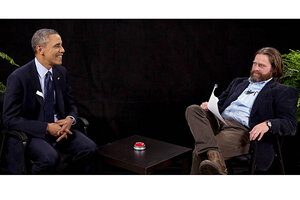Obamacare ads race for Millennials as deadline looms
Obamacare ads portraying everything from singing cats to Richard Simmons are specifically targeted at getting the 18 million uninsured Americans aged 18 to 23 to sign up before the March 31 deadline. But digital-first, politically ambivalent Millennials are hesitant about Obamacare.

President Obama, left, with actor-comedian Zach Galifianakis during a March 11 appearance on Funny or Die's 'Between Two Ferns,' the digital short with a laser focus on reaching people aged 18 to 34. Strategists have focused on using viral events like the president's 'Between Two Ferns' appearance to try and convince young adults to sign up for Obamacare before the March 31 deadline.
Funny Or Die/AP/File
•"Recently Insured Man Can't Wait To Get Out There, Start Seriously Injuring Himself," reads a faux headline advertising "Obamacare."
•A six-hour health-insurance promo event, streamed on YouTube, featured a dance-off with fitness guru Richard Simmons as the host chanted: "Get covered! Get covered!"
•A series of videos portrayed singing cats and a rapping pug directing people to GetCoveredAmerica.com. "Now you can still get covered and buy me treats," sings a bulldog.
The target of these million-dollar ad campaigns are the elusive so-called young invincibles – 18 million Americans ages 18 to 34 who were uninsured as of 2012. The nation's new health-care insurance system needs these young people, who don't cost the system too much, in order to pay for other, more costly populations. But digital-first, politically ambivalent Millennials are hesitant about opting to enroll in Obamacare – a December Harvard Institute of Politics poll found 57 percent of young adults don't support the Affordable Care Act – and have been slow to sign up. With a March 31 deadline looming, pro-Obamacare ads have grown increasingly wild, drawing unprecedented scrutiny as well as ire. Critics ask: Is this any way to educate young people?
"Insurance companies have been trying the conventional methods for years," says Adam Fox, a strategist for a Denver-based health-care advocacy group, which made waves with its own off-beat ads. "Really, we were trying to come up with a social media campaign that would cut through the noise and be a little bit humorous." Mr. Fox says their ad page garnered more than 23.5 million hits, plus massive social media play.
In early March, President Obama appeared on Zach Galifianakis's parody talk show, "Between Two Ferns," and pushed HealthCare.gov. The video spawned more than 29,000 Twitter mentions in six hours, analytics firm Sysomos found. What didn't go viral was the message: Only 1,375 tweets mentioned HealthCare.gov. However, traffic to the website shot up 40 percent the day Obama's interview was posted.
The anti-Obamacare side has gone to similar wacky lengths to convince young adults not to sign up. Under the law, those who don't sign up pay a penalty that is less than insurance premiums.
"Going viral doesn't hurt, but the pro-Obamacare people had a product that didn't work," says Corie Whalen, a spokeswoman for GenOpp, a conservative Millennial group. "They can have as many cat memes as they want ... but if your product is bad, it doesn't matter."
Experts question the pro-Obamacare ads. "Getting their attention is one thing ... but then getting them to go 'Huh, I should get health insurance' is another thing," says Doug Hough, an economist at Johns Hopkins University and author of "Irrationality in Health Care." "We have to be treating these Millennials with more respect."
By the end of February, 18-to-34-year-olds accounted for 25 percent of the current sign-ups, according to Health and Human Services, well below the 40 percent mark the Congressional Budget Office predicted would be the case by the time the deadline rolls around. Despite the campaigns and ads aimed at them, the proportion of young adults signing up through exchanges in February was only up three percentage points.
But health-care groups say it's likely that young people are waiting until the last minute. Already enough have signed up that premiums won't skyrocket. The Kaiser Family Foundation estimates that even the worst-case scenario – young people accounting for 25 percent of the enrollees – would only drive rates up an extra 1 to 2 percent in coming years.
So have the millions of dollars spent on the campaigns been worth it? Millennials aren't so sure.
"I think a lot of the advertising has been politicized, even when it hasn't been political," says Michael Puzio, a data-entry temp in his mid-20s from Linden, N.J., who signed up for insurance through the federal exchange in November. "People are struggling on a daily basis and yet the Internet mocks the government attempting to actually help people and persuade people who aren't paying attention."
Marcea Copeland-Rodden, a small-business owner in her late 20s from Monument, Colo., said the only ad that stood out to her featured two people with opposite opinions discussing the health-care law. The ad directed viewers to a website on which they could continue the conversation.
"We realize there are two sides to every story," she says. "It didn't have a side and I didn't just filter it." Ms. Copeland-Rodden signed up for health insurance in December.

